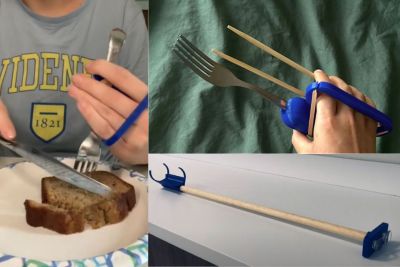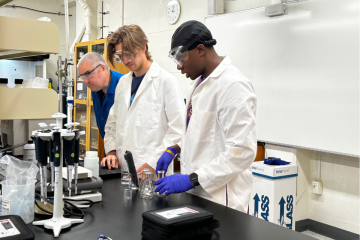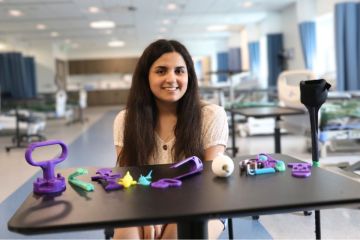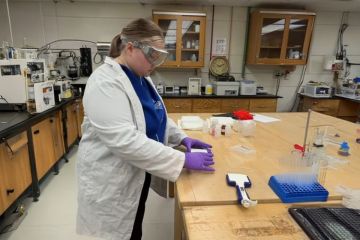The Power of Collaboration: Widener Innovation Takes the Global Stage

Three groups of students from the undergraduate robotics engineering program and the graduate occupational therapy program successfully teamed up for an international 3D printing and assistive technology design competition, with impressive results.
The students were named finalists in the Make:able Challenge after creating and entering assistive devices designed to improve the day-to-day life of people with a disability. The challenge was presented by PrintLab, a 3D printing curriculum developer based in the United Kingdom, and Autodesk, a software developer for architecture, engineering and construction headquartered in San Francisco.
Professors Monique Chabot and William Nagel oversaw the collaboration, which marked a first between the programs.
“It was interprofessional from the start,” said Chabot, associate professor of occupational therapy. “These projects are so impressive and are perfect examples of the power of interdisciplinary collaboration.”
By partnering across disciplines, Chabot and Nagel’s goal was to foster interprofessional collaboration and introduce the students to a different area of practice and expertise. In meeting that goal, the projects also put Widener innovation on an international stage.
“In our categories, it’s over (age) 18 so the undergrads and the graduates are going up potentially against professionals and some real heavy hitters,” said Nagel, assistant professor of robotics engineering.
Among their submissions was Dexterity Mate, an adaptable utensil and chopstick holder created by occupational therapy students Tina Lee ‘24 and Jamella Fagan ‘24 and robotics engineering student Dylan Hermann ‘25. The device was designed specifically for Lee’s father, who lives with Parkinson’s Disease, to assist him with mealtime.
“It came naturally that he was the one who came to mind because that's something that he's been struggling with,” said Lee, whose father experiences tremors and limited mobility predominantly on his right side, which impacts his ability to eat with a utensil or chopsticks.
Throughout the semester-long project, the group investigated the use of weighted utensils, a common interventional tool for individuals with Parkinson’s Disease. After research and evaluation, they pivoted their approach and printed a handle to fit around the user’s hand, as well as a built-up band, or cuff, which enabled increased speed and efficiency with a utensil.
“Instead of making [the device] weighted, we decided that the built-up handle was more useful for my dad, and then we worked around that,” said Lee.
For the future occupational therapists, the project demonstrated the importance of not only understanding a client’s specific need, but identifying ways to build inclusive equipment that can serve a range of needs and be customizable, such as an attachment for chopsticks.
“We made it as an attachment so if someone doesn't need or use chopsticks on a daily basis or in their daily life, they could not print it,” said Lee.
A staple in engineering, the use of 3D printing is becoming more prevalent in the occupational therapy field as it relates to assistive device technology. Widener’s occupational therapy program recently purchased two 3D printers to give students access to the growing practice.
Even with the equipment available to these students, Fagan noted that the collaboration with engineering was crucial, as it provided technical insight and knowledge of the software.
“It was hard for us to understand the 3D printer and the technical requirements and even to troubleshoot different issues that we had,” Fagan said.
Representing the engineering perspective, Hermann brought experience with 3D programming and printing to the project.
“I had a good bit of knowledge for the 3D printing and CAD modeling aspect and [Fagan and Lee] had a good bit of knowledge about what it was that we were trying to do, so it was a lot of them putting it in terms that I could understand,” said Hermann.
As a result, Hermann was introduced to the world of assistive devices and gained a deep understanding of real-world software applications and how they can translate into the job market.
“It was really neat to see all the different pre-existing implements to aid people with disabilities and model what already existed, emulate that and then advance on it a little bit to help make something to help Tina’s dad,” said Hermann. “It was really eye opening and it's definitely something I'm considering moving forward.”
Explore all three of the Widener team finalists:
Phone Reacher - Best Use of 3D Printing category
Created by Marie McMearty (OT), Cory Ciuca (Robotics), Chris Girardo (OT), and Steven Robinson Jr. (OT)
Spork - Best Showcase of Customization and Best Showcase of Iterative Design categories
Created by Emmily Zerr (OT), Liliana Pokropski (OT), Ronald Carr (Robotics), and Aidan Wilson (Robotics)
Dexterity Mate - Best Showcase of Iterative Design category
Created by Tina Lee (OT), Jamella Fagan (OT), and Dylan Hermann (Robotics)



